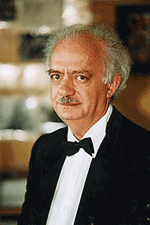> [Archived] Interviews

The composer Boris Dubosarschi: 'I am not a foreigner, I grew up here.'
Sunday, September 4th 2011, starting from 17:00, in the programme of the National Chamber Orchestra of the Republic of Moldavia, conducted by Cristian Florea on the stage of the Romanian Athenaeum, there is also one of Boris Dubosarschi's works: The Chamber symphony for string orchestra, string quartet and timbals.
What determined you to compose a symphony for such an orchestra: string orchestra, string quartet and timbals?
The theme of string orchestras is very familiar to me because I myself am a violinist, I am professor of violin at the Music Academy, and during the years when I composed this work I was still playing in the Moldavian Radio string quartet. And as the string quartet is in itself a concentrated entity, this idea came to me - why don't I compose a work for a string quartet and orchestra?!
…and the timbals?
The timbals constitute also a concentrated part with their own dramatic and psychological load. They are part of the orchestra, but they are not here just as percussion instruments, having the role to emphasize certain accents; they have an independent, soloist line. That is why Slonimski, a composer from Petersburg, seeing the score, has remarked: 'You succeeded to create a very melodious line of the timbals!'
When did you compose this symphony?
The symphony was written in the year 1978 and interpreted for the first time by the Philharmonic Orchestra conducted by Timofei Gurtovoi, at that time its principal conductor, an emeritus artist of the USSR. After a year, at the plenum of the Composer's Union, it was played under the conduction of Alfred Gersfeld, a conductor living now in the United States of America. This time it was played by the Radio Chamber Orchestra from Moldavia. Afterwards, for many years, this symphony has not been played anymore, other works of mine being played. Now I decided to bring it back to light, of course, with some changes, even if they are less important. The current version, realized by the wonderful musician, conductor Cristian Florea, impresses me because it reveals something new.
A few words for the audience: in what lays the originality of this symphony, how should it be listened to and understood?
From the point of view of the musical format, it does not respect entirely the tradition; it is a symphony in three parts and not in four, and even if I do not see myself as a path breaker, because tripartite symphonies existed in the time of Haydn too, still, a symphony in three movements is rare. And it is not just about its tripartite structure, but also that from the dramatic point of view, the middle part is missing in this symphony, adagio or andante how they would be called. In exchange, this is balanced out by slow episodes like, for example, the ample introduction from the first part. The same first part is ending with a high, uncoiled cadenza of the string quartet, on the background of the timbals: also, very slow. I also used intonations of the doina - Moldavian and Romanian - in this cadenza.
What exactly determined this format? Does the symphony have a programme?
…It is not linked to a certain literary programme, but my intention was to unravel some interior human emotions or themes as man and society, man and nature. It could be said that there is a programme of this type, and in the music this can be heard…
What is the role of the folkloric element in this work?
A very big one: it is not a cited folklore, the thematic material is mine. It keeps the most direct links to the folklore of our republic, inseparable of the Romanian one, because we are talking of related countries, and the minor differences met in diverse areas do not change the situation: we are talking about the same nation, the same people, the same language - it was always like this. I was born in Bessarabia, my parents were here since before the war and that is why I'm not a foreigner. I grew up here.
Translated by Izabella Feher
MTTLC, Bucharest University














